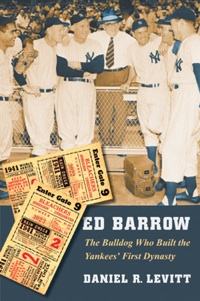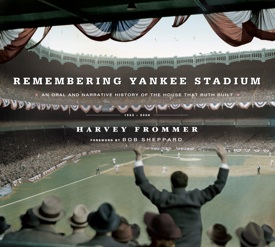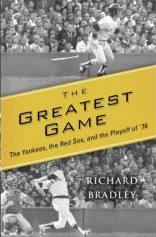 On the last page of his biography of Ed Barrow, author Daniel R. Levitt allows a long quote from Branch Rickey to close out his tome. “I say there has never been a smarter baseball man than Mr. Barrow,” Rickey once said. “He knows what a club needs to achieve balance, what a club needs to become a pennant winner. I, perhaps, can judge the part, but Mr. Barrow can judge the whole.”
On the last page of his biography of Ed Barrow, author Daniel R. Levitt allows a long quote from Branch Rickey to close out his tome. “I say there has never been a smarter baseball man than Mr. Barrow,” Rickey once said. “He knows what a club needs to achieve balance, what a club needs to become a pennant winner. I, perhaps, can judge the part, but Mr. Barrow can judge the whole.”
These are glowing words from one of the men considered to be among the smartest baseball minds in the game’s history. It is a quote, in fact, better served for the first page of a book. Branch Rickey, one of baseball’s most famous executives, talks about Ed Barrow, one of the games most influential — but not quite as well known — executives, in positively glowing tones.
With that type of quote setting the stage, Levitt as the author of a biography would have had free reign to build up Ed Barrow’s life and accomplishments in baseball. Instead, the quote is buried. This is but one of the many missed opportunities that arise in Levitt’s informative but misguided biography of a man who deserves so much more.
For many Yankee fans, the name Ed Barrow is lost to time. But he was part of the game for fifty years and nearly half of those he spent constructing Yankee dynasties. He saw baseball emerge as a big business in the early 1900s, won a World Series ring as a manager, help bring the Babe and Lou Gehrig and Joe DiMaggio to New York, ushered the Yanks through the dark days of World War II and sat on a committee to bring in some of the Hall of Fame’s first members. Throughout those years, he was a key player in establishing first formal relationships between minor league clubs and Major League teams and later building up the farm team system we know and love.
But Levitt doesn’t always bring across just who Ed Barrow was. Early on in the book, Levitt introduces Barrow as a stubborn hot-head with little taste for the internal politics of baseball. He is very much the bulldog in the book’s subtitle, “The Bulldog Who Built the Yankees’ First Dynasty.” While we learn this much about Barrow in the late 1890s, for the next fifty years, Levitt relies on that trope to tell Barrow’s story. At turn after turn, meeting after meeting, he doesn’t get what he wants because of his stubbornness.
While reading the book, I couldn’t help but feel that there was more to the story. I never got a sense of who Barrow was, and he seemed almost incidental to Levitt’s year-by-year recitation of Yankee — and baseball — history. Now and then, bits and pieces of Barrow’s personal life are interspersed into the baseball narrative, but one gets the sense that Barrow either had no life outside of baseball or just wasn’t an interesting enough person to warrant a biography.
When the book first hit stores in April, Levitt ran through the blog circuit. Rich Lederer at Baseball Analysts interviewed him, and Baseball Prospectus chatted up the author as well. Those Q-and-A’s better serve to introduce Barrow than the book does, but that doesn’t mean the tale is not one worth reading.
Levitt’s book works best as a story of the development of the game from a pastime that was incidentally a poorly-run gathering of businesses into a big money-making business with tentacles throughout America. The appendices to the book are chock full of payroll and salary statistics from an era prior to free agency, and his superb detailing of the uneasy relationship between the Major and Minor League is a story rarely, if ever, told. In the end, Barrow, influential at the time, is almost incidental to the story Levitt ultimately tells.
Ed Barrow: The Bulldog Who Built the Yankees’ First Dynasty is available on the University of Nebraska Press. Cover price is $29.95, but Amazon has it for $21.86. I am, however, a firm believer in supporting local bookstores.
 Remembering Yankee Stadium, Harvey Frommer’s illustrated and oral history of the House that Ruth Built, starts on a high note and keeps getting better. Bob Sheppard, the Yankee PA announcer, out all of this season as he convalesced from a serious illness, offers up his introduction to the impressive tome.
Remembering Yankee Stadium, Harvey Frommer’s illustrated and oral history of the House that Ruth Built, starts on a high note and keeps getting better. Bob Sheppard, the Yankee PA announcer, out all of this season as he convalesced from a serious illness, offers up his introduction to the impressive tome. Before delving into the game, Richard Bradley, author of The Greatest Game: The Yankees, the Red Sox, and the Playoff of ’78 (Free Press, $25), sets a high bar for himself. How exactly does one go about determining the “greatest game” ever with such certainty?
Before delving into the game, Richard Bradley, author of The Greatest Game: The Yankees, the Red Sox, and the Playoff of ’78 (Free Press, $25), sets a high bar for himself. How exactly does one go about determining the “greatest game” ever with such certainty? As most RAB readers already know, the three of us are rather fond of ESPN’s Rob Neyer. He’s got a new book out, Rob Neyer’s Big Book of Baseball Legends. This is the third, and he claims final, of his “Big Book” series. Previously, there was the Big Book of Baseball Lineups and the Big Book of Baseball Blunders. In “Legends,” Neyer looks back at baseball tall tales, and through the aid of fact-checking, let’s us know how accurate each one is.
As most RAB readers already know, the three of us are rather fond of ESPN’s Rob Neyer. He’s got a new book out, Rob Neyer’s Big Book of Baseball Legends. This is the third, and he claims final, of his “Big Book” series. Previously, there was the Big Book of Baseball Lineups and the Big Book of Baseball Blunders. In “Legends,” Neyer looks back at baseball tall tales, and through the aid of fact-checking, let’s us know how accurate each one is.  It’s not often I find myself eagerly awaiting the release of a video game, but this year The Show couldn’t come out soon enough. I had read
It’s not often I find myself eagerly awaiting the release of a video game, but this year The Show couldn’t come out soon enough. I had read  The graphics though, holy cow are they phenomenal. They added something like 3,500 new animations, including massive upgrades to the crowd, stadiums, and even the environment outside the stadiums. In addition to the basic player specific batting stances, there are now player specific swings. Wanna take that big long healthy cut with A-Rod? You can do it. Maybe you just wanna inside-out a pitch to the opposite field with Jeter; that’s in their too.
The graphics though, holy cow are they phenomenal. They added something like 3,500 new animations, including massive upgrades to the crowd, stadiums, and even the environment outside the stadiums. In addition to the basic player specific batting stances, there are now player specific swings. Wanna take that big long healthy cut with A-Rod? You can do it. Maybe you just wanna inside-out a pitch to the opposite field with Jeter; that’s in their too.